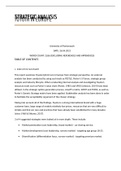STRATEGIC ANALYSIS
STRATEGIC MANAGEMENT
TOYOTA IN EUROPE
University of Portsmouth
DATE: 26.04.2021
WORD COUNT: 2266 (EXCLUDING REFERENCES AND APPENDICES)
TABLE OF CONTENTS
1. EXECUTIVE SUMMARY
This report examines Toyota hybrid cars in Europe from strategic perspective. An external
analysis has been conducted by using such tools as PESTLE, Porter’s 5 Forces, strategic group
analysis and industry lifecycle. When conducting internal analysis and investigating Toyota’s
resources tools such as Porter’s value chain (Porter, 1985) and VRIO (Johnson, 2019) have been
utilised. In the strategic option generation process, Ansoff’s matrix, SWOT and TOWS, as well as,
Porter’s Generic Strategy matrix have been applied. Stakeholder analysis has been done in order
to facilitate the acceptability argument of the chosen strategy.
Taking into account all of the findings, Toyota is a strong international brand with a huge
customer base, large range of models relatively low prices, resources that are very difficult to
imitate and that are rare and practices that have already been established for many decades
(since 1960’s)( Nkomo, 2017).
3 of 4 suggested strategies were looked at in more depth. These include:
• Market penetration (cost leadership, broad market) - car sharing service.
• Market development (cost leadership, narrow market) - targeting age group 18-25.
• Diversification (differentiation focus, narrow market) - targeting premium market.
,2. INTRODUCTION TO TOYOTA
Toyota Motor Corporation is a Japanese global company specialising in motor vehicle production
and sales, which achieved a net income of 2,076 billion yen in March 2020 (More to Toyota than
Meets the Eye, 2020). The company is widely popular with its Toyota Production System (TPS).
Toyota created the concept of lean manufacturing, which is about elimination of waste, for
instance, time and capital. Furthermore, it is about efficient processes with short delivery lead
times and Just in Time production (JIT), which minimises stock (Lean manufacturing made
Toyota the success story it is today, 2021).
3. STRATEGIC ANALYSIS
In this chapter, the internal and external analysis of Toyota will be conducted in a business and
industry level.
3.1. PESTLE ANALYSIS (APPENDIX 1)
The most crucial factors to the automotive industry and Toyota are mentioned below.
TECNOLOGICAL: car industry is built on technology. Thus, knowing the trends in technology is a
key. A Forbes article has named self-driving vehicles, electric vehicles, development of charging
stations accessible to everyone and increase in demand for car sharing as the three main
changes impacting the industry. Toyota is already developing self-driving vehicles (More to
Toyota than Meets the Eye, 2020) in order to keep up with these changes.
ENVIRONMENTAL: EU consideration to toughen the pollution regulations (Krukowska, 2020) will
impact the demand of hybrid/electric cars in the EU in a positive way. For Toyota it will be an
opportunity to increase hybrid sales even further and gain higher market share. Toyota’s
Environmental Challenge 2050 may further facilitate the EU decision to implement pollution
cutting goals and regulations.
3.2. PORTER’S 5 FORCES
For a full analysis, see appendix 2.
, The barriers of entry are relatively high due to high start-up costs, fixed costs and need for
innovation. Toyota as an established, innovative company is in a strong position.
The competitive rivalry in the industry is considered high due to constant price wars between
competitors (Johnson, 2019). There are not many competitors for Toyota that produce hybrid
cars, but considering PESTLE factors, due to rapid technological developments and society
striving for sustainable world, the competition building environment-friendly cars will increase
in time.
The customers hold a low buyer power against Toyota due to Toyota’s large customer base and
constant innovation of new products (Porter five forces analysis, 2019). As long as it stays this
way, the buyer power will not increase. By launching new car models and services (for example,
KINTO car-sharing), the buyer power will decrease.
The supplier power is low regarding regular car parts, because the market is crowded with
suppliers that can offer the components. But, hybrid technology specific suppliers are more
difficult to find so the power is higher. Furthermore, the fact that with JIT production, Toyota is
very dependent on its suppliers, the supplier power is higher.
The threat of substitutes is low due to Toyota offering cheap cars that produce less CO2
emissions. People are not very likely to choose more expensive cars, especially during times like
coronavirus pandemic. The income is lower and people are choosing cheaper alternatives. The
only threat is that more people may choose alternatives, like, train, bike or walking rather than
buying a car.
3.3. STRATEGIC GROUP ANALYSIS (APPENDIX 3)
The strategic group analysis focuses on a few largest car manufacturers in the EU market. In
automotive industry, Toyota seems to have a lower market share compared to Volkswagen or
PSA Group. However, the product range is the second highest of all the companies compared
and the average price of a car is towards the lower end (Figure 1). It puts Toyota in a strong
position against its competitors, because customers like to have a choice and paying lower
prices. Closest competitor in prices and range is VW. With high market share, if they decide to
go where Toyota is going, that would be a threat to the company.
There is a gap in low range high price space (Figure 1). Taking into account PESTLE factors, for




